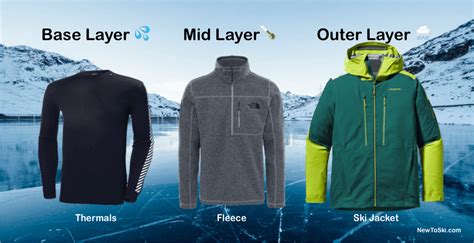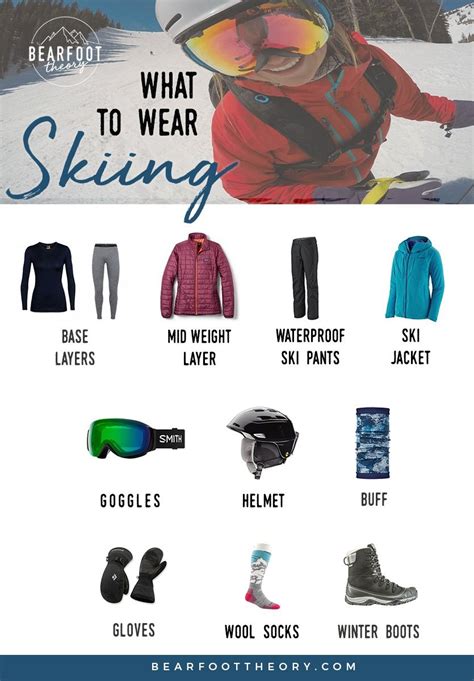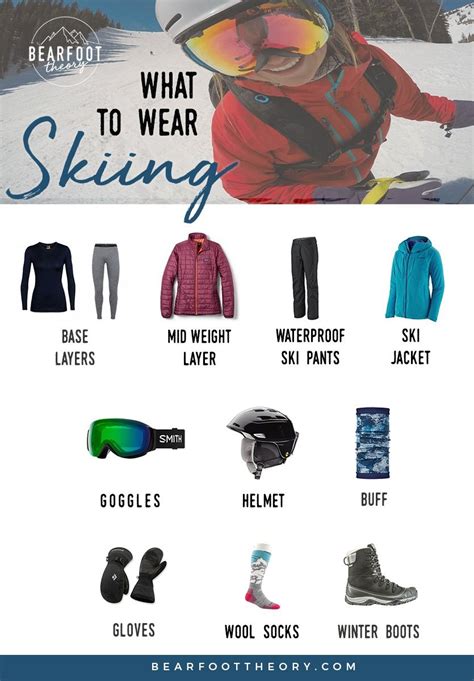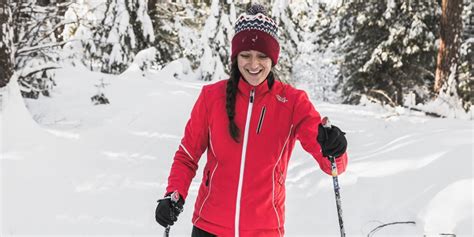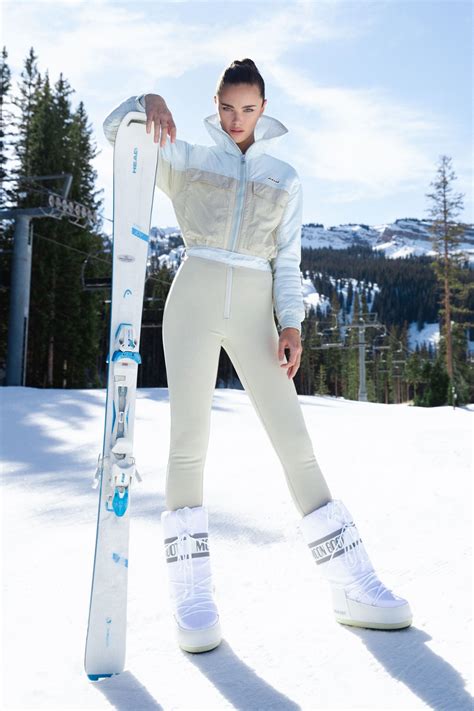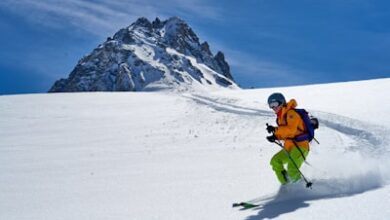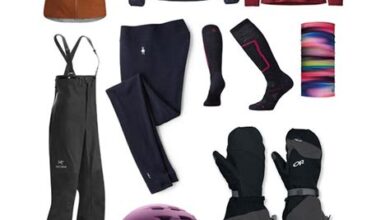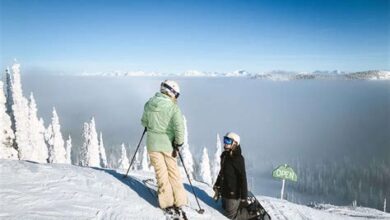How To Layer For Skiing?⏬
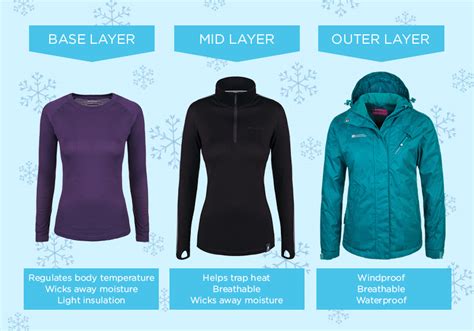
Learn the best layering techniques for skiing, including backcountry, cross-country, and après-ski, to keep warm and comfortable on the slopes.As the winter snow blankets the mountains, the thrill of skiing beckons adventurers to the slopes. Whether you’re slicing through the backcountry, carving down high-speed trails, or gliding across peaceful cross-country paths, staying warm and comfortable is crucial for a day spent in the embrace of the cold. Dressing appropriately can mean the difference between an exhilarating experience and a chilly disaster. In this comprehensive guide, we’ll delve into the art of layering for skiing, covering everything from the dynamic needs of backcountry travel to the après-ski transition where style meets warmth. Discover how to construct the best layering system that adapts to your activity, keeps you dry from inside out, and enhances your performance while zooming on skis or boards. So, slip on your gloves, adjust your goggles, and prepare to master the layers that will accompany you down every powdery slope and across each frosty trail.
How To Layer For Backcountry Skiing
Proper layering is critical for a successful and comfortable backcountry skiing adventure. Understanding the best layering system for skiing will not only enhance your performance but also protect you from the cold and unpredictable weather conditions. While discussing how to layer clothing for skiing, it is important to start with the base layer, which should be made of moisture-wicking material to keep you dry from sweat.
When venturing into the frosty backcountry, the mid-layer comes into play by providing insulation. Possessing knowledge of how to layer for skiing and snowboarding demands that you choose a mid-layer which can adapt to the fluctuating body temperatures, usually a fleece or a lightweight down sweater. The outer layer, or shell, must be waterproof and breathable; this outermost defense against the elements is vital for protection against wind and snow.
In the case of how to layer for cross-country skiing, breathability becomes even more crucial as this type of skiing is an intense workout requiring layers that vent well. For this style of skiing, a softshell might be preferable, allowing for greater mobility and air flow. And finally, no discussion on ski layering would be complete without a mention of how to layer for après ski, where style meets warmth. Here, your outer layers would typically transition to more casual, trendy options, like insulated jackets or elegant wool coats.
Below is a detailed table highlighting the essentials of ski layering:
| LAYER | FABRIC TYPE | PURPOSE | EXAMPLES |
|---|---|---|---|
| Base Layer | Moisture-wicking materials such as merino wool or synthetic fibers | To keep skin dry and regulate body temperature | Merino wool leggings, synthetic long-sleeve tees |
| Mid-Layer | Fleece, down, or synthetic insulation | To provide insulation and retain body heat | Fleece jackets, lightweight down sweaters |
| Outer Layer | Waterproof and breathable fabrics | To shield against wind, snow, and rain | Waterproof shells, softshell jackets |
| Additional Layers | Varies | Optional layers for added warmth or weather protection | Insulated pants, neck gaiters, buff |
And there we have it, whether you’re carving down high alpine slopes or enjoying the après ski ambiance, layering for skiing is all about balancing warmth, ventilation, and movement. By closely following these guidelines, skiers can ensure they’re adequately prepared for a day in the backcountry or the resort.
Best Layering System For Skiing
Understanding the best layering system for skiing is crucial for comfort and performance on the slopes. The key is to maintain a core temperature that is warm enough to prevent hypothermia, yet cool enough to avoid overheating and excessive sweating. Ideally, your ski attire should be built up in layers which can be easily added or removed depending on weather conditions and personal comfort levels. Layering effectively allows you to stay dry and warm, and it also provides flexibility as you move between different environments on the mountain.
Firstly, the base layer is your ski wear’s first line of defense. It’s the layer in direct contact with your skin, and its primary function is to manage moisture and maintain body heat. Materials like merino wool or synthetic fibers are excellent for base layers since they wick moisture away from the body and dry quickly. The base layer should fit snugly to help transfer sweat to the outside, where it can evaporate without cooling you down too much.
Moving on to the mid-layer, which provides the main insulation and retains body heat to keep you warm. This layer typically consists of materials such as fleece, down, or synthetic insulation that traps warm air. The thickness of the mid-layer can be adjusted according to the temperature; on warmer days, a thinner fleece might suffice, while colder conditions may necessitate a thicker down jacket.
The outer layer, or shell, is designed to protect you from wind, snow, and water. It should be breathable to allow moisture to escape and be sufficiently robust to withstand the rigours of skiing. Features to look for in a good shell include sealed seams, waterproofing, and wind-resistance.
Lastly, accessorizing with gloves, a beanie, and ski socks is also part of the overall layering system for skiing. Hands and feet are particularly susceptible to the cold, so ensuring these extremities are well-insulated is essential. When selecting gloves, opt for those with waterproofing and insulation, and for socks, choose materials that mirror the attributes of a good base layer, such as moisture-wicking and quick-drying properties.
To illustrate the layering system clearly, the following table provides an overview:
| Layer | Function | Material Examples |
|---|---|---|
| Base Layer | Moisture Management | Merino Wool, Synthetic Fibers |
| Mid-Layer | Insulation | Fleece, Down, Synthetic Insulation |
| Outer Layer | Weather Protection | Gore-Tex, Nylon, Other Waterproof/Breathable Fabrics |
| Accessories | Extremity Protection | Waterproof Gloves, Wool/Synthetic Blend Socks, Beanie |
Remember that when it comes to layering for skiing, adaptability is key. Be prepared to shed or add layers depending on how your body feels, the weather conditions, and the intensity of your skiing. With the right layering system, you’ll be able to focus on the thrill of the slopes without the distraction of discomfort caused by the elements.
How To Layer Clothing For Skiing
Understanding the art of how to layer clothing for skiing is essential for comfort and performance on the slopes. The right layering system can mean the difference between a day of enjoyable runs and an uncomfortable experience with the winter chill. When planning your ski attire, consider each layer as an integral component of your personal microclimate, working together to provide warmth, moisture management, and protection from the elements.
The base layer is your moisture-wicking second skin, usually made from synthetic fabrics or merino wool, which helps to keep you dry by transporting sweat away from your body. This is crucial because wet skin can quickly become cold skin, especially in the frosty environment of the mountains. For the best layering system for skiing, your base layer should fit snugly without restricting movement.
Moving on to the middle layer, this is where the insulation comes into play. Its purpose is to trap and retain the warmth generated by your body. Key materials for this layer include fleece, down, or synthetic insulators. The fitting can be more relaxed, providing room for air, which is an excellent insulator, to be trapped within the fibers, thus adding to your warmth.
The outermost layer, or the shell layer, shields you from wind and precipitation. A high-quality, breathable, and waterproof jacket and pants are paramount for how to layer for skiing and snowboarding. Features such as vents can also help regulate your body temperature, preventing overheating during rigorous activity and allowing you to adjust your personal climate based on weather conditions or physical exertion.
For those engaging in the more strenuous activity of backcountry skiing or cross country skiing, it’s important to consider the intensity of the exercise and the likely increase in body heat it will generate. Start with a lighter base and mid-layer, or opt for more breathable fabrics to avoid overheating. All of these principles can also apply to how to layer for après ski, where style and warmth must merge for the perfect balance of comfort and social acceptability.
| Layer | Function | Material Examples |
|---|---|---|
| Base Layer | Moisture Management | Synthetic, Merino Wool |
| Mid Layer | Insulation | Fleece, Down, Synthetic |
| Shell Layer | Protection | Waterproof, Breathable Fabrics |
- Always select a base layer that fits close to the skin to aid in moisture management.
- The mid layer should offer ample insulation without hindering your range of motion.
- Choose an appropriate shell layer based on the weather conditions you’ll be encountering.
- When backcountry skiing, adjust layers based on activity level and sweat production.
- Apres-ski attire should balance style with the practical need for warmth and comfort.
How To Layer For Skiing And Snowboarding
When preparing for a day of skiing or snowboarding, understanding the principle of layering is essential for comfort and protection from the elements. Layering your clothing allows you to adjust your body temperature as the weather changes or as your activity level increases or decreases. Let’s dive into the best strategies for layering to ensure a fun and safe experience on the slopes.
The Base Layer is your first line of defense against the cold and serves to wick moisture away from your skin. A good quality base layer is made from materials like merino wool or synthetic fibers, designed to keep you dry and warm throughout your activities. For skiing and snowboarding, it is recommended to choose a base layer with a snug fit to maximize its moisture-wicking capabilities.
Moving on to the Mid Layer, its primary function is to provide insulation and retain the body heat you generate. The mid layer should be breathable enough to release excess heat, yet capable of trapping the necessary warmth. Fleece jackets, down vests, or synthetic insulation materials are excellent choices for this layer, as they are designed to balance insulation with ventilation.
The Outer Layer is critical for shielding you from wind, snow, and rain. A high-quality, waterproof, and breathable shell jacket and pants are non-negotiable for your comfort and safety on the mountain. Key features to look for include sealed seams, venting options, and a durable water-repellent (DWR) coating to prevent moisture from penetrating your other layers.
In addition to the core layering system, consider the importance of accessories such as socks, gloves, a hat, and a neck gaiter. These items should complement your layering strategy by providing extra insulation where you need it most without compromising dexterity and overall comfort.
| Layer | Function | Materials |
|---|---|---|
| Base Layer | Moisture Wicking | Merino Wool, Synthetics |
| Mid Layer | Insulation | Fleece, Down, Synthetic Insulators |
| Outer Layer | Weather Protection | Gore-Tex, DWR Coatings |
As you gear up for your next skiing or snowboarding adventure, remember that the key to comfort is in the layers. Tailor your apparel to the weather conditions, your level of activity, and personal preference. By following these guidelines, you’re set for an enjoyable experience on the slopes, whether carving down the mountain or enjoying the snow-laden scenery.
How To Layer For Cross Country Skiing
While embarking on a cross country skiing adventure, understanding the intricacies of how to layer properly becomes crucial to maintain comfort and warmth without overheating. The dynamic nature of this sport means that body temperature will fluctuate, and therefore, so must your layers. The key to an efficient layering system is to build versatility that can adapt to varying weather conditions and personal heat production.
The foundation of layering for cross country skiing begins with a moisture-wicking base layer. This is instrumental in keeping your skin dry as it transports sweat away quickly, thus avoiding the chilling effect that occurs when moisture condenses on the skin. Typically, materials like synthetic polyester or merino wool reign supreme for their superior moisture management and odor resistance.
Moving up to the mid-layer, this component serves as the main insulator. Its primary role is to retain body heat while still allowing for breathability. A lightweight fleece or a thin down jacket, preferably with zippered vents, can provide necessary insulation while affording the ability to regulate temperature by unzipping when the body warms up during strenuous movement.
The outer layer, often a softshell or a light windproof jacket, is the final protective shield against the elements. It should be breathable yet able to fend off wind and light precipitation. For cross country skiing, where aerobic activity is high, heavy-duty hardshell jackets can be overkill, hence opting for a less bulky, more breathable outer layer is advisable.
| Layer | Material | Function |
|---|---|---|
| Base Layer | Polyester/Merino Wool | Moisture-Wicking |
| Mid-Layer | Fleece/Thin Down | Insulation |
| Outer Layer | Softshell/Windproof Jacket | Element Protection |
Remember, the success behind your cross country skiing experience is highly influenced by how well you can manage your body temperature through appropriate layering. Keeping essentials easily accessible – such as gloves, hats, and neck gaiters – allows for quick adjustments on the trail. Furthermore, prioritizing layers that offer zippers and ventilation options will enable you to maintain a comfortable microclimate, no matter the conditions that Mother Nature presents.
How To Layer For Apres Ski
Understanding the proper way to layer for Après Ski means striking a balance between cozy comfort and stylish flair. As the social aspect of skiing takes center stage post-slopes, the ability to navigate layering can be as crucial as your prowess on the skis themselves. Après Ski isn’t just about unwinding with friends; it’s also about showcasing a touch of personal style while maintaining a level of warmth to combat the evening’s chill.
Begin with a breathable, moisture-wicking base layer that serves as your foundation. Opt for materials like merino wool or high-tech synthetics which offer both warmth and dryness. While a base layer remains unseen, its functionality in preventing post-activity chills cannot be overstated; it discreetly wicks away sweat as the body cools down.
The middle layer, which serves as the insulating component, should adjust easily with the fluctuating temperatures typical of mountain environments. A down sweater or a fleece jacket, pieces known for their superior warmth-to-weight ratio, are ideal choices. The beauty of such layers is that they not only provide insulation but also double as fashionable standalone pieces when the outer layer is removed indoors.
As for the outer layer, a chic, weather-resistant jacket or coat that reflects personal style while offering additional insulation is key for Après Ski attire. This layer often features a zip or button front, making it simple to shed upon entering a cozy lodge or cabin. While it’s the bulkiest layer, it should still allow for ease of movement and interaction.
Finally, to create a practical yet stylish Après Ski outfit, don’t forget the accessories. Knit hats, scarves, and gloves in coordinating colors add a functional yet fashionable touch. A pair of waterproof, insulated boots keeps you warm and stable on icy surfaces while remaining on-trend.
Below is a table summarizing the key elements of an effective Après Ski layering system:
| Layer | Description | Materials |
|---|---|---|
| Base Layer | Moisture-wicking and breathable, stays in contact with the skin | Merino Wool, Synthetic Fabrics |
| Middle Layer | Provides insulation and can be worn as a standalone in mild conditions | Fleece, Down, Synthetic Insulators |
| Outer Layer | Stylish yet functional, protects against wind and precipitations | Weather-Resistant Fabrics |
| Accessories | Enhances overall warmth and adds a touch of personal style | Wool, Acrylic, Blends |
By considering each layer carefully, anyone can blend into the Après Ski scene with both elegance and ease, guaranteeing warmth and sociability as the daylight fades and the firelight beckons.
Frequently Asked Questions
What is the purpose of layering for skiing?
Layering for skiing is designed to help manage body temperature, protect against the elements, and wick away moisture. This enables skiers to stay warm, dry, and comfortable while on the slopes, regardless of changing weather conditions.
How many layers should you typically wear when skiing?
Typically, skiers should wear three main layers: a base layer for moisture management, a mid-layer for insulation, and an outer layer for protection against wind and precipitation.
What is the ideal material for a base layer when skiing?
The ideal material for a base layer is a synthetic or wool fabric that has moisture-wicking properties. This helps to keep perspiration away from the skin, preventing the skier from feeling cold and clammy.
Can you explain the function of the mid-layer in ski attire?
The mid-layer serves as the primary insulating layer, trapping body heat to keep you warm. Common materials for the mid-layer include fleece, down, or synthetic insulators, which are designed to retain warmth while maintaining breathability.
What are the characteristics of a good outer layer for skiing?
A good outer layer for skiing is waterproof, windproof, and breathable. It should have features like sealed seams, venting options, and a durable fabric to protect against the elements while allowing excess heat and moisture to escape.
Is it necessary to have special features in ski clothing, such as pit zips or powder skirts?
While not necessary, features like pit zips and powder skirts offer additional functionality that can enhance comfort. Pit zips allow for ventilation to cool down quickly, and powder skirts prevent snow from entering the jacket when skiing in deep snow.
How do you accommodate changing weather conditions while skiing?
To accommodate changing weather conditions, you can adjust your layers accordingly. This might involve adding or removing the mid-layer, using venting options in your outer layer, or adjusting accessories like hats and gloves to ensure you remain comfortable on the slopes.


